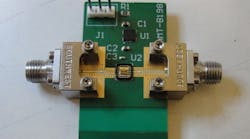The quad flat no-leads (QFN) package is a low-cost, lead frame-based package that’s very common in the semiconductor industry. QFN packages have small footprints and adapt well to most silicon devices, so long as they’re not overly complex with hundreds or thousands of ball or wire-bond leads.
Quik-Pak wanted to take the QFN package to a new level with an air-cavity version. Think of a ceramic package with silicon within, attached to a lead frame and surrounded by air, but in a plastic version with a copper lead frame and a lid over the device. Without epoxy potting material to be stripped away, such a package lends itself to silicon debugging, as well as to high-volume production.
To that end, Quik-Pak, together with Agile Microwave Technology (AgileMwT) and OMMIC SA, has completed RF characterization of its new line of JEDEC-compliant, air-cavity QFN packages. The Quik-Pak open-molded plastic packages (OmPP) are RF-capable to frequencies of 43 GHz, which will help speed availability of semiconductor devices for 5G and internet of things (IoT) millimeter-wave applications.
Each company contributed core technology to the characterization project: Quik-Pak’s OmPP air-cavity open-molded QFN packages, AgileMwT’s interconnect design and test capabilities, and OMMIC’s millimeter-wave monolithic microwave IC (MMIC) gallium nitride (GaN)-based design and manufacturing processes. The team successfully completed electrical RF characterization of the OMMIC die (a low-noise amplifier capable at frequencies up to 53 GHz), and Quik-Pak’s OmPP package. Using a standard, off-the-shelf package with no customization, performance was verified to about 43 GHz with very low insertion loss, according to Ken Molitor, Quik-Pak’s chief operating officer.
Quik-Pak offers custom lead frames and laminate substrates that will likely extend that frequency range, but according to Molitor, “the sweet spot is 43 GHz and below.” The air-cavity packages come with up to 100 leads and up to a 12- x 12-mm square form factor. Package height is about 1 mm.
Millimeter-wave radio frequencies are well-suited for 5G networks. Unlike the sub-5-GHz frequencies previously used by mobile devices, millimeter-wave technology allows transmission on higher frequencies previously used primarily by radio systems and satellites. Today, these frequencies are being used to connect mobile devices to base stations, as well as for IoT and other applications that require much higher data rates and reliability and lower latency. Moreover, using wide-bandgap GaN die allows devices to reach high power densities (up to 4 W/mm) and output power in a smaller space with greater power efficiency and low energy consumption, promoting robustness in high-frequency devices for 5G applications. As use of these technologies and interconnected communications grows more widespread, a near-infinite number of solutions stands to benefit from the Quik-Pak air-cavity QFN packages.
The packages are available now from Quik-Pak as both off-the-shelf and custom offerings.
Quik-Pak, www.icproto.com
